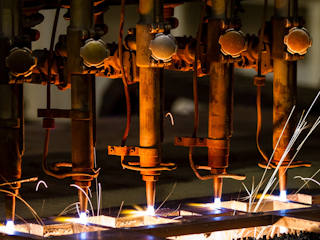abril 23, 2023
The World Agri-Tech Innovation Summit in March 2024 hosted more than 2,500 business leaders dedicated to exploring the global movement necessary to protect and strengthen the world's agri-food supply chain.
At the summit, moderator Cameron Turner, who became Vice President of Data Science at Kin + Carta in 2020, hosted the panel “Empowering Agriculture through AI Democratization.” Valtech acquired Kin + Carta in April 2024.
The following recap details the discussion among panel members, who included:
-
Nalini Polavarapu, Vice President of Data Science and Enterprise Analytics at Bayer
-
Feroz Sheikh, Chief Information and Digital Officer for Syngenta Group
-
Ranveer Chandra, Chief Technology Officer for Agriculture and Food at Microsoft
Overall, the panel explored the critical need for the democratization of AI in all environments — from enterprises to farmers. Clearly demonstrating the value of AI is integral to this process and can be accomplished through use cases. Where adoption rates are low, practical engagement and personalization are potential approaches to improvement.
AI and democratization
The panel's opening question addressed how we experience AI democratization today, as we’re well past the need to establish an understanding of the concept and vision. The agricultural industry is instead focusing on deployed AI solutions that are effective in real-world environments.
The panel first looked at democratization as a means to open AI to a wider audience. Easier access and a low barrier to entry, especially for individuals with varying skill sets, will allow them to use and derive value from the technology.
Another vision of democratizing AI is to remove the need for farmers to depend on guesswork and supplement their knowledge with data-driven decision-making capabilities. The goal is to replace speculation with AI solutions that are feasible and affordable, regardless of location.
The point was also made that the societal aspect of agriculture is integral to democratization. The example used was of farmers in India choosing to dump their produce rather than take it to market. In this case, the available data ran contrary to what would be expected, indicating that the transport cost would exceed their profit.
Leveraging technology to democratize access to modern advancements for all farmers, regardless of their technological expertise or financial status, is one of the most important factors in democratization.
In addition, democratization within the realm of innovation is necessary to ensure smaller companies and startups have equal opportunities to bring new products and services to the market alongside larger corporations.
The key vision we have is, and all of us, I think, share that vision is how do you replace that guesswork with AI and make it feasible, affordable so that any farm anywhere in the world, in India, in Africa, in South America can start using data and AI
— Ranveer Chandra, Chief Technology Officer for Agriculture and Food at Microsoft
Providing value with use cases
Convincing farmers there is value in data from AI when they already have extensive knowledge about their own soil and land is also a challenge. The more granular, high-quality and hyper-local an AI model’s data is, the better — while keeping affordability in mind.
When examining AI democratization, there has to be a balance between data quality, which results in improved decisions, and affordability, which affects AI technology adoption.
There are two points to consider in terms of data:
-
How to acquire critical data
-
How to enable data sharing without compromising privacy or proprietary models
Having access to farmers’ data in combination with generic farm-level data is ideal, but when privacy concerns are preventing adoption, a bridge is necessary. Solutions like Azure Confidential Computing, which allows secure sharing by only decrypting data in hardware, can be integral to this process.
Discussing how to solve the last mile problem, the panel talked about the evolution of AI transitioning from humans interacting with computers to computers understanding humans.
This type of use case can be as simple as developing a WhatsApp plugin that lets farmers determine their eligibility and apply for a subsidy in natural language, eliminating the need for them to go to an intermediary for help. One conclusion was that this is a perfect demonstration of AI's potential to streamline interactions and communicate knowledge.
In practice, the need isn’t for more technology but for technology that reduces friction and creates smoother interactions among existing systems.
At the same time, increasing the rate of AI adoption remains a challenge. The panel considered the perspective that this roadblock can be overcome by demonstrating clear value propositions for AI applications in agriculture. In retail recommendation engines, there is room for error, but impractical, inaccurate or overly expensive recommendations to a farmer can be devastating.
Agricultural AI requires high quality data to ensure the accuracy and effectiveness of suggestions, especially given the significant impact they can have on farmers' livelihoods. The crop is only as good as its soil, and AI is only as good as its data.
If we are in particular talking about democratization, it's important to see where that cost versus scale balance is, that better data would result in better decisions. But to bring it to a point where it is scalable and affordable, only then it'll reach the adoption.
— Feroz Sheikh, Chief Information and Digital Officer for Syngenta Group
Practical engagement and personalization
A collaborative effort is necessary to drive innovation and address the multifaceted challenges and opportunities when looking at how farmers use AI. One critical piece, open benchmarks for agriculture, is missing. Open benchmarks are especially important because digital transformation has caused problems in agriculture in the past. Research has shown that when evaluating the effectiveness of digital transformation, agriculture ranked last when compared to 23 other industry verticals.
Good data benchmark sets are also needed so comparisons can be made between different models. Without addressing these two knowledge gaps, innovation is stifled. In fact, without benchmarks, a lift value can’t be generated, and any resulting value statement will inevitably be flawed.
Further to that idea, there is a contrast between farmers’ innate knowledge of their own farms with the influence of unpredictable factors like the changing environment. The use of benchmarking and AI models would be a positive step toward running complex scenarios where several factors, such as soil conditions, climate and product effectiveness, intersect. The panel encouraged everyone in the audience to take on these kinds of challenges.
The issue of practical engagement with AI is further complicated by the difficulty of predicting climate patterns due to climate change. With innovation, it’s possible that AI could replace obsolete historical models to help improve weather predictions while factoring in genetic and environmental interactions.
How to balance ease of adoption with value is an ongoing question for AI applications. For farmers, particularly those with limited technology skills, there is a very real challenge in making AI tangible for day-to-day farming operations.
Generic answers from large language models won’t be sufficient to help farmers. Personalized recommendations tailored to individual farms, overlaid with contextual data, are fundamental to the success of AI. The style of AI adoption has evolved to the point that, rather than developers presenting a solution, farmers are identifying where AI can help them and asking developers to build the tools they need.
Another important attribute of conversational interfaces like chatbots and voice interactions is that they let farmers ask for and receive personalized, real-time recommendations in the field.
Integrating budget sheets and contextualizing farming decisions within the framework of running a business could enhance the value of AI applications for farmers. The next step may be the rise of multimodal interactions, such as voice, text, images and even videos, as well as the use of generative AI for tasks like creating marketing materials.
Another layer to the need for multimodal interactions requires the inclusion of multimodal data collection. There is an apocryphal belief that the most popular variety of seed always appears first in the drop-down list. If this is true, it means current data collection isn’t ideal and will lead to bad outcomes for AI. Data collection has to be accurate and be gathered from a diverse set of sources to provide accurate recommendations.
We see so many people knocking on our doors and say: ‘I think I can use AI for this particular solution. Can you build it for me?’ So, that's how the shift happened from push to that pull thing.
— Nalini Polavarapu, Vice President of Data Science and Enterprise Analytics at Bayer
Conclusion
From farmers to innovators, AI democratization requires accessibility to a wider audience, innovative approaches to streamline interactions, natural language interfaces, practical engagement, relevant use cases and personalized recommendations tailored to individual farms.
Data-driven decision-making will undeniably improve agricultural productivity and sustainability. Diverse, high-quality data and innovative AI models are the best way forward to create a more sustainable and resilient agri-food supply chain for the future.












